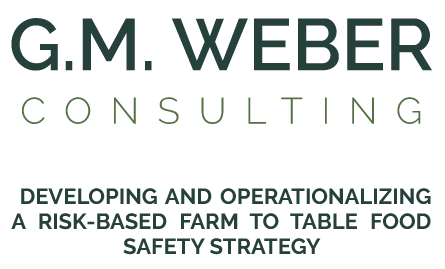When a serious foodborne illness occurs in your organization, time is of the essence. The outbreak could stem from your supplier, from within your kitchen, and many other vulnerable spots within the supply chain that will reach your customers. My experience can benefit:
- The relationship between a retail food service organization and their supplier
- Suppliers or retail food organizations considering legal counsel as a result of an outbreak
- Firms interested in identifying the cause of a foodborne illness outbreak.
- And many more managers, organizations, and suppliers along the food chain

Examples:
On a produce farm, the grower follows the recommended set-back distance from a large livestock operation, however analysis of an outbreak linked to their product finds the road to the livestock operation is in very close proximity to the implicated field. An analysis of dust from the road illustrates the presence of an E. coli. The concept of “setbacks” should include a consideration of corridors where livestock and or equipment travel.
In 2012, one of several Hepatitis strain 1b outbreaks occurred in Europe reportedly resultant from imported berries. In June of 2013 and 2016 there were two Hepatitis strain 1b outbreaks in the United States linked to frozen berries from the same region as identified in Europe. At the time, the government and most industry experts did not view Hepatitis strain 1b as a “known or reasonably foreseeable to occur hazard” and few “berry matrix” analytical methods were available. Being aware of global health events and implications for the movement of food products rejected by other countries, but offered for sale in the US, is worthy of consideration in a preventive controls plan.
In at least two Listeria monocytogenes (LM) outbreaks, or implicated outbreaks, cleaning and sanitation was identified as a likely source of the product contamination through aerosolization of water and residues. The aerosolized material likely ended up on product or on Zone 1 food contact surfaces. Investigations found cleaning was occurring while ready-to-eat products were being packaged nearby. As early as 1997, Bil Mar Foods were aware of LM issues. By the fall of 1998, there were 15 deaths reportedly linked to the firm. Subsequent investigations at the firm identified cleaning and sanitation that aerosolized the LM containing water and residues was linked to the spread of LM to ready to eat foods. Understanding “lessons learned” from previous outbreaks may have prevented these LM outbreaks.
Numerous outbreaks of Salmonella linked to imported tuna were found to be highly related to major storm events that likely caused raw sewage discharge into rivers and ultimately to fishing grounds. It is possible water used in processing was also contaminated due to the storm events. Monitoring major storm events as an element of a FSVP preventive controls analysis might prevent this type of outbreak.
High profile outbreaks associated with products made from wheat flour have occurred in 2009 and again in 2016 associated with pizza dough. In the 2016 outbreak, the CDC reported 63 people infected with the outbreak strains of STEC O121 or STEC O26 from 24 states, 17 of which were hospitalized. One person developed hemolytic uremic syndrome, a type of kidney failure. No deaths were reported.
2% of the total annual production of flour from the implicated major manufacturer was recalled due to the 2016 STEC related outbreaks.
Questions that should have been considered in this situation:
- Is contamination of flour by various STEC’s a “hazard reasonably likely to occur”?
- Is the addition of reduced iron, a necessary element for the efficient growth of E. coli, to flour and long proofing times adding to the risk?
- Is the Food Code’s recommendation to cook plant-based products to 135 degrees F adequate?
- After proofing dough contaminated with an STEC, what is the estimated MPN or CFU of the dough and what cooking temperature is adequate to provide a kill step?
- Do firms using flour know that STEC contamination may be a known or reasonably foreseeable hazard?
- Would more open discussions of the risks have helped firms monitor cooking temperatures of pizza dough and other products?
The following research reports are examples of data analysis the could have helped prevent four related outbreaks.
- Raw wheat, in-process wheat flour, and finished wheat flour in Australia were analyzed for various microbiological populations (Berghofer et al., 2003). E. coli was not recovered in raw wheat; however, tempered wheat was contaminated at 14% and finished wheat flour was contaminated at 1%. The level of E. coli in finished wheat flour was 9 MPN/g.
- In 1989, a total of 4,796 flour samples from various wheat types and seasons of milling were analyzed for indicator microorganisms. The overall average incidence of E. coli was 1.32% (n=3,040), respectively (Richter et al., 1993).
- A microbiological survey of milled cereal grains was also conducted (mostly from 2003 to 2005) using routine data from North American dry-milling operations (Sperber et al., 2007). For wheat flour, the average levels of microbiological populations were: aerobic bacteria at 4.41 log CFU/g, coliform bacteria at 3.64 log CFU/g (Petrifilm method), E. coli at 0.84 log CFU/g (Petrifilm method), mold at 2.58 log CFU/g, and yeast at 1.79 log CFU/g. Levels of coliform bacteria and E. coli were lower when MPN methods were reported. Salmonella was present in 0.14% of wheat flour (n=4,358).
- One of the most current and complete discussions regarding microbiological contamination of wheat and flour was written by Cassie Alexandra Palm Anderson.
- Ardent Mills developed a white paper that serves as a practical guide regarding the issues of microbial contamination of wheat flour.
The FDA has recently updated their Hazards Guide to include STEC’s in flour; listing STEC’s as a hazard for flour, but the Food Code still doesn’t address the proper cooking temperatures and time to kill this and other potential pathogens in dough products.
- What happens to these potential pathogen levels in dough products after they go through a “long” proofing time at room temperature or above?
- In hindsight, would being aware of this information alter the “preventive controls” implemented by firms using dough-based products?
When Foodborne illness outbreaks occur
At what point should you reach out for help if you are experiencing an Outbreak?
Immediately!
Let’s face it: it is difficult to prevent every possible hazard that could lead to a food contamination event, accidents can and will happen. We can assist you quickly if a serious foodborne illness occurs. Time is of the essence! My understanding of the Preventive Controls, Produce Safety, Foreign Supplier Verification rules, outbreak and other data analysis can be of great benefit through:
- Analyzing the outbreak epidemiological and traceback/forward data to assist in identifying and bracketing time frames and recall scope.
- Working across your supply chains to align communications.
- Assisting you in understanding how the CDC, FDA and State Health departments may perceive and act as a result of your decisions.
- Determining “root cause” and re-engineering of the Preventative Control plan, supplier plans and verification, including FSVP requirements.
Time is of the essence and every moment has great importance on how you handle the aftermath of an outbreak.

Outbreak Experience History
While serving as the Prevention Manager for the FDA’s Coordinated Outbreak Response and Evaluation Network (CORE) I was involved in the following outbreaks from the detection stage through response and post response activities. From May 2013- through July 2017.
Pathogens and Related Food Vehicles
Leafy Greens, Flour/dough based products, Alfalfa Sprouts, Romaine Lettuce, Chicken Salad/celery, Green Cabbage, and Spinach
Bagged Salad, Cilantro
Scallops, Pomegranate Arils, Strawberries
Frozen Vegetables, Soft Cheese, Hummus, Leafy Greens, Stone Fruit, Ice Cream, Caramel Apples
Oysters
Salmonella includes enteritidis, anadem, braenderup, oranienburg, paratyphi B variant, weltevreden, reading, ebony, cubana, bredeney, bovismorbificans, bareilly, agona, javiana, newport, heidelberg, mbandaka, montevideo, stanley, saint paul, senftenberg.
Cucumbers, Hot Peppers, Pistachios, Leafy Greens, Tuna, Shell Eggs, Sprouts, Yellow Onions, Pine Nuts, Sesame Seeds, Pistachios, Mung Bean Sprouts, Papaya, Tomatoes, Peanut Butter, Romaine Lettuce, Cashews
Includes Scrombrotoxin, Tetrodotoxin, Ciguatera “Rhabdomyolysis”
Buffalo Fish, Barracuda, Mackerel, Tuna (Ahi, Yellowtail), Mahi, Escolar
Clams, Oysters
